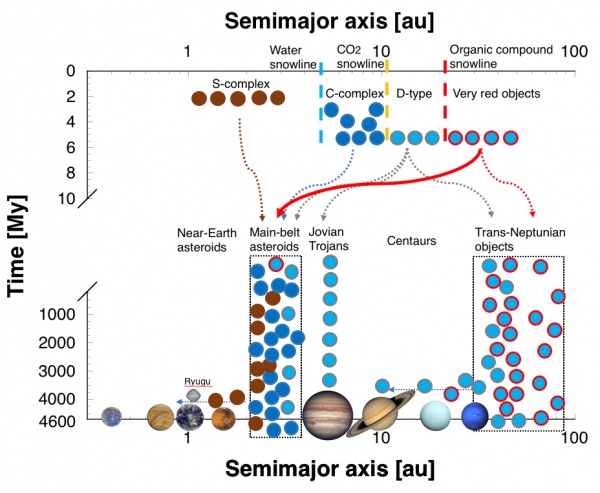Two Bizarre red Asteroids Somehow Migrated From the Kuiper Belt all the way to the Main Asteroid Belt
By Andy Tomaswick
If asked to pick what color asteroids in the asteroid belt would be, red is likely not one that would come to mind for most people. But that is exactly the color of two new asteroids found by Hasegawa Sunao of JAXA and an international team of researchers. The catch is the objects don’t appear to be from the asteroid belt at all, but are most likely Trans-Neptunian objects that were somehow transported into what is commonly thought of as the asteroid belt. How exactly they got there is still up for debate.
The two asteroids, known as 203 Pompeja and 269 Justitia, were originally thought to be D-type asteroids, are rich in silicates and carbon, and make up the majority of the Jupiter Trojan asteroids that orbit behind the giant planet. There is a group of these types of asteroids called the Cybeles which make up their own separate group of asteroids a little farther out from the larger belt.

Credit – Astronomical Image – NASA, Ryugu Image – JAXA, Hasegawa et al.
However, the two new asteroid’s spectral lines were “too steep”, making them much more like the “Centaurs” – a body that is larger than an asteroid but smaller than a planet that orbits between Jupiter and the Kuiper belt. The reddish color they reflect is indicative of having organic compound on its surface, which is one of two distinct categories Centaurs can be – the other one being “blue”.
That spectra makes 203 Pompeja and 269 Justitia unique in the asteroid belt, but they are similar to their asteroid neighbors in other ways, such as their size (110km diameter for Pompeja and 55km diameter for Justitia) and their orbit, which puts them right in the middle of the traditional asteroid belt. But why a Trans-Neptunian Centaur would migrate into the asteroid belt remains a mystery.

Credits: NASA/Goddard/University of Arizona
One way to solve that mystery might be to go visit. Hayabusa-2 and OSIRIS-REx are two recent successful missions that visited asteroids and are bringing back valuable material samples from their surfaces. Another mission to these unique asteroids would not be out of place, as it might both give some insight into how they ended up there and also help collect samples from examples of objects that otherwise only exist much further out in the solar system.
Currently the discoveries are recent enough that there are no plans for any such visit. However, there is still plenty of remote sensing power that can be directed their way while plans are drawn up. There might even be more of these reddish objects in the belt that could be first noticed given the increased attention received from this recent discovery.
Learn More:
JAXA – If we’re ready to explore, how about these destinations? Discovery of very red bodies in the asteroid belt that resemble trans-Neptunian objects.
NYT – 2 Red Objects Were Found in the Asteroid Belt. They Shouldn’t Be There.
Engadget – Two red objects between Mars and Jupiter may explain how the solar system formed
Gizmodo – Astronomers Spot Two Unusually Red Objects in the Asteroid Belt
Lead Image:
The spectra of the two red objects shows a different curve than found in other objects near them in the asteroid belt.
Credit – Hasegawa et al.
The post Two Bizarre red Asteroids Somehow Migrated From the Kuiper Belt all the way to the Main Asteroid Belt appeared first on Universe Today.

August 3, 2021 at 07:52PM
via Universe Today read more...

Post a Comment